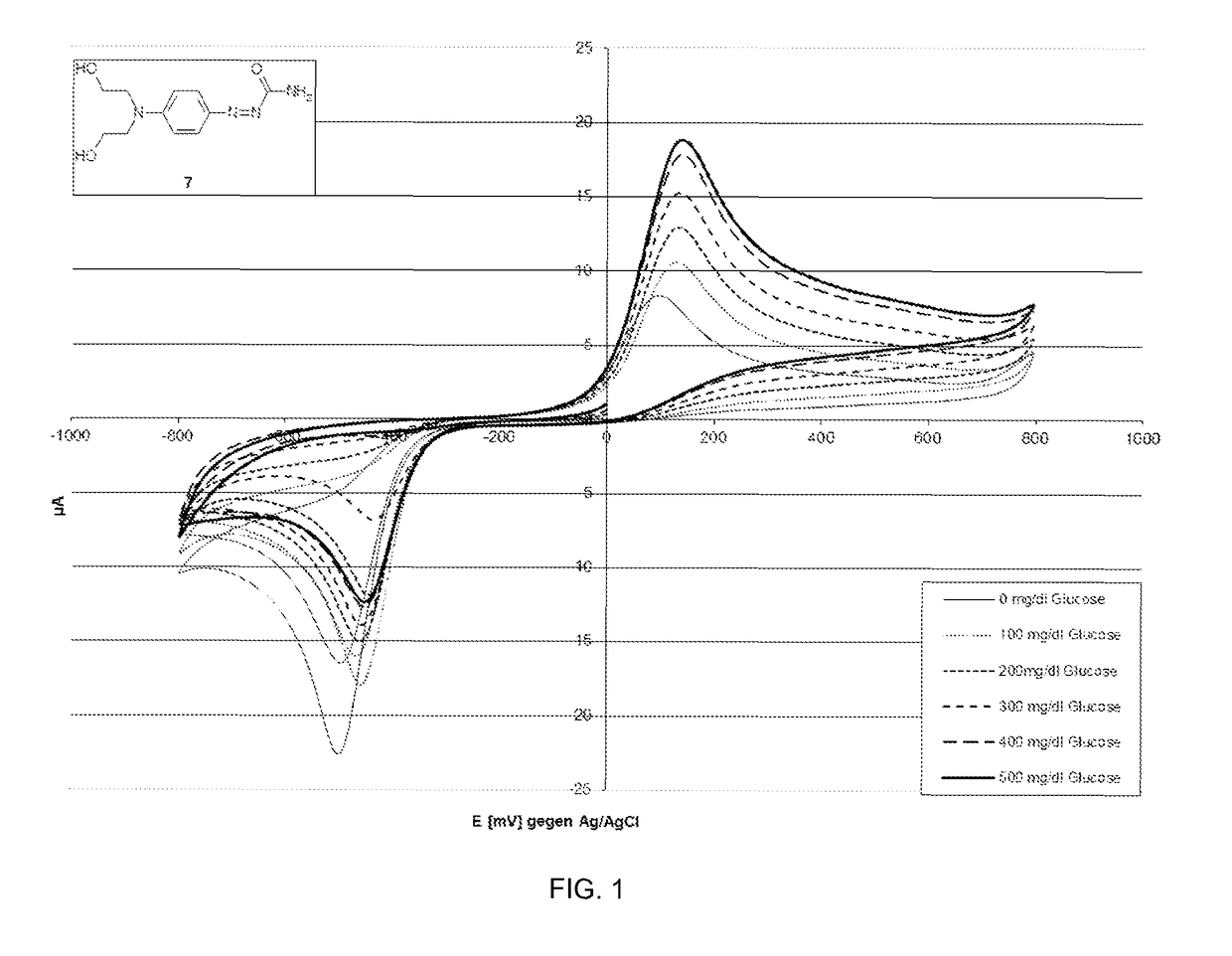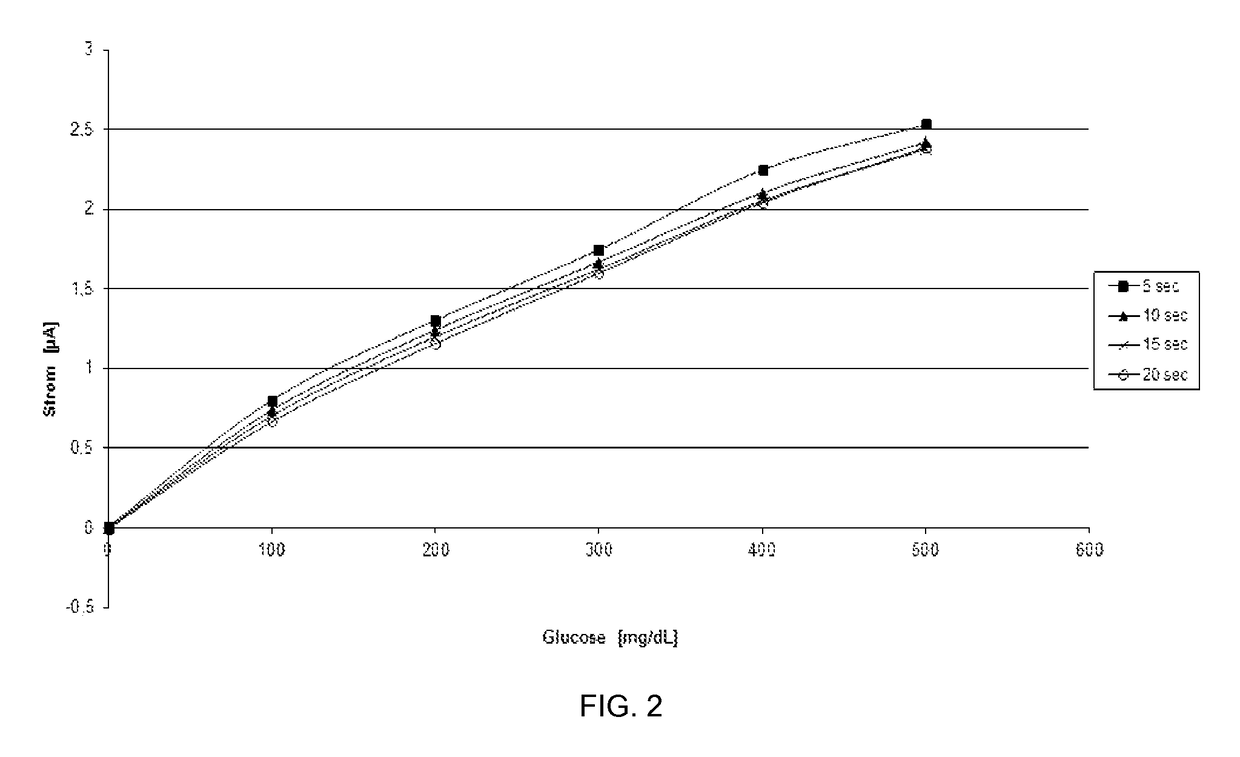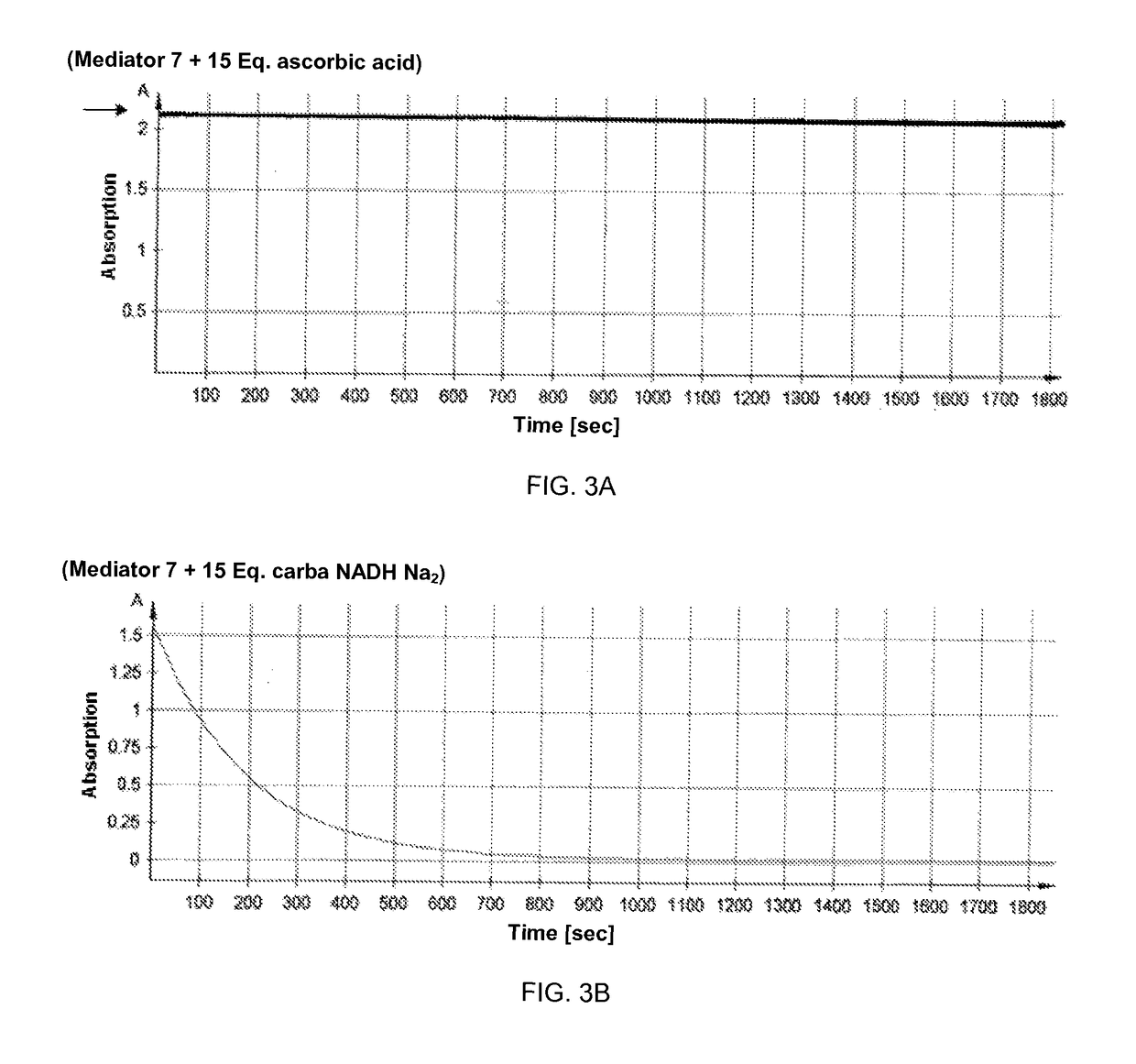Azo mediators and methods of use thereof
a mediator and azo technology, applied in the field of azo compounds, can solve the problems of undesired side reactions, high reactivity, adversely affecting the specificity and sensitivity of the determination of analyte concentration, etc., and achieve the effect of avoiding blank reactions and avoiding undesired side reactions
- Summary
- Abstract
- Description
- Claims
- Application Information
AI Technical Summary
Benefits of technology
Problems solved by technology
Method used
Image
Examples
example 1
of Azo Compounds
Synthesis of 2-[(2-hydroxyethyl)-(4-nitrophenyl)-amino]-ethanol (3)
[0075]
[0076]1-fluoronitrobenzene (1) (1.00 ml, 9.38 mmol) and diethanolamine (2) (2.73 ml, 28.5 mmol) were dissolved in 20.0 ml dimethyl sulfoxide (DMSO) and refluxed for 4 hours at 140° C. Afterwards, the solvent was removed under reduced pressure (3 mbar, 80° C.), and an orange-colored oil remained that was dissolved in a mixture of ethyl acetate (C4H8O2) and water (H2O). The organic phase was separated, washed several times with H2O and dried over magnesium sulfate (MgSO4). After removing the solvent under reduced pressure, 1.35 g (63%) of the title compound was obtained.
Synthesis of N,N-bis(2-hydroxyethyl)-4-aminoaniline dihydrochloride (4)
[0077]
[0078]2-[(2-hydroxyethyl)-(4-nitrophenyl)-amino]-ethanol (3) (1.35 g, 5.97 mmol) was dissolved in 100 ml conc. hydrochloric acid (HCl; 37%), tin (II) chloride dihydrate (SnCl2.2H2O; 8.07 g, 26.5 mmol) was added, and it was refluxed for 1.5 h at 105° C. Aft...
example 2
ng Redox Behaviors of the Azo Compounds
[0101]The redox behavior of representative azo compounds as described herein was investigated as part of an evaluation on the extent to which azo compounds of the general formula (I) can be used as a mediator in diagnostic methods.
[0102]Methods: A solution of 4-[bis-(2-hydroxyethyl)-amino]-benzenediazocarbamide (7) (5 mM in 0.2M potassium phosphate buffer pH 7.0, 0.9% NaCl, 0.5% Triton X-100) was prepared. After adding FAD-dependent glucose dehydrogenase (20 mg / ml), 10 μl of a glucose solution (concentration: 0 mg / dl, 100 mg / dl, 200 mg / dl, 300 mg / dl, 400 mg / dl and 500 mg / dl) was added to 40 μl of this solution and preincubated for 5 min.
[0103]Subsequently a cyclovoltagram against Ag / AgCl was recorded. The potential was firstly changed continuously from 0 mV to −800 mV and subsequently back to +800 mV, and finally to −100 mV, and the currents that flowed were measured. The change in potential per unit of time was 100 mV / sec. The results of these...
example 3
of Converting Glucose Using the Azo Compounds
[0105]To further evaluate the redox behavior of the azo compounds as described herein, the kinetics of converting glucose solutions of different concentrations was examined in the presence of NAD-dependent glucose dehydrogenase, carbaNAD and 4-[bis-(2-hydroxyethyl)-amino]-benzenediazocarbamide (7).
[0106]Methods: A solution of 4-[bis-(2-hydroxyethyl)-amino]-benzenediazocarbamide (7) and carbaNAD (each 25 mM in 0.2M potassium phosphate buffer pH 7.0, 0.9% NaCl, 0.1% Triton X-100) was prepared. After adding NAD-dependent glucose dehydrogenase (20 mg / ml), 10 μl of a glucose solution (concentration: 0 mg / dl, 100 mg / dl, 200 mg / dl, 300 mg / dl, 400 mg / dl and 500 mg / dl) was added in each case to 40 μl of this solution, whereupon carbaNADH was formed by the enzyme / glucose reaction, which in turn resulted in a reduction of the azo-based mediator.
[0107]The kinetics of the conversion were determined amperometrically immediately after addition of the gl...
PUM
| Property | Measurement | Unit |
|---|---|---|
| concentrations | aaaaa | aaaaa |
| concentrations | aaaaa | aaaaa |
| concentrations | aaaaa | aaaaa |
Abstract
Description
Claims
Application Information
 Login to View More
Login to View More - R&D
- Intellectual Property
- Life Sciences
- Materials
- Tech Scout
- Unparalleled Data Quality
- Higher Quality Content
- 60% Fewer Hallucinations
Browse by: Latest US Patents, China's latest patents, Technical Efficacy Thesaurus, Application Domain, Technology Topic, Popular Technical Reports.
© 2025 PatSnap. All rights reserved.Legal|Privacy policy|Modern Slavery Act Transparency Statement|Sitemap|About US| Contact US: help@patsnap.com



